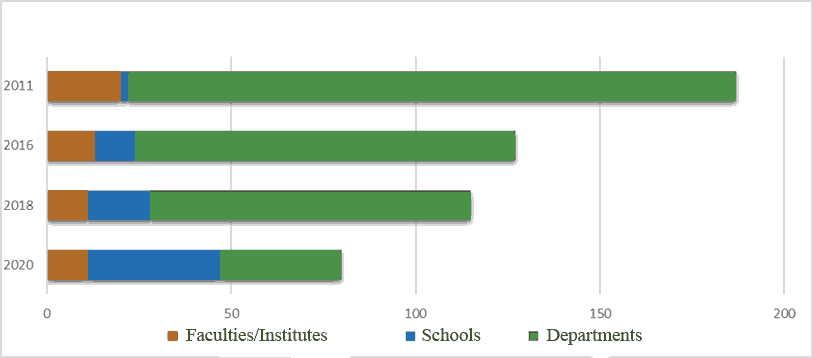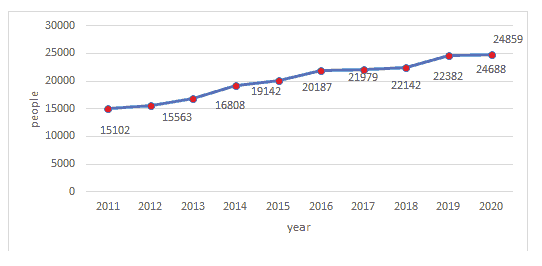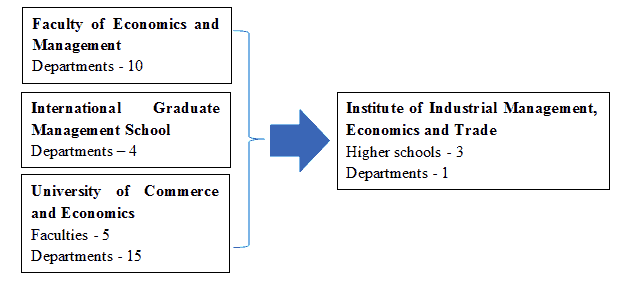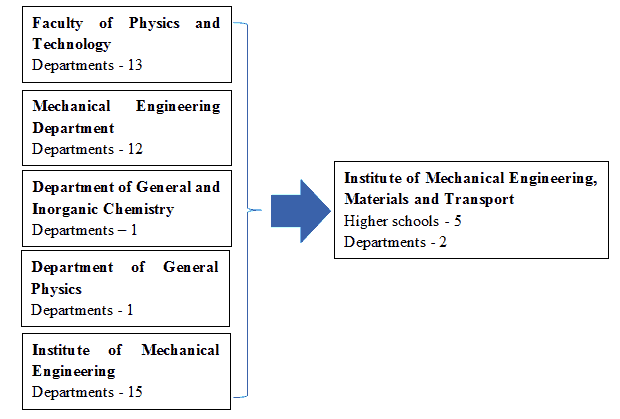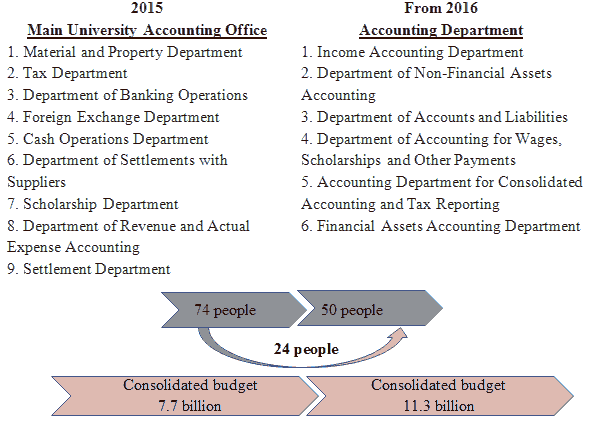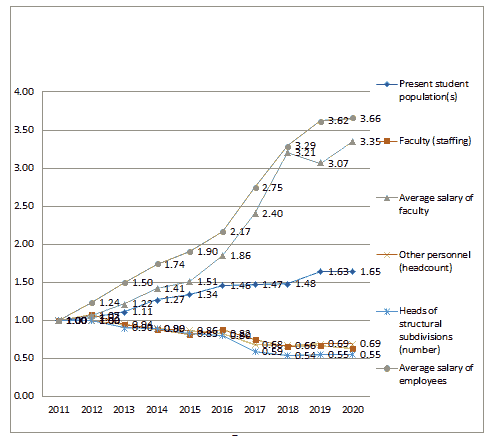Research Article: 2022 Vol: 25 Issue: 2S
Improving university organizational and financial structures: Case of digitalization in russia
Elena Borisovna Vinogradova, Peter the Great St. Petersburg Polytechnic University
Olga Vladimirovna Kalinina, Peter the Great St. Petersburg Polytechnic University
Citation Information: Vinogradova, E.B., & Kalinina, O.V. (2022). Improving University Organizational and Financial Structures: Case of Digitalization in Russia. Journal of Legal, Ethical and Regulatory Issues, 25(S2), 1-11.
Abstract
The management structure of the modern university should reflect the goals and objectives of the organization taking into account current trends of the digitalization and innovative business models. The paper discusses the methodological aspects to forming organizational structures and organizational changes in the system of higher education in the context of digitalization. An approach has been developed to studying the modernization processes of organizational and financial structures of a university, using the case study of St. Petersburg Peter the Great Polytechnic University, which can be applied to improve financial performance, and the quality of management decisions aimed at enhancing educational and scientific activities of the university. The purpose of the article is the research of the goal-setting process and related organizational changes introduced by the university in a changing external environment.
Keywords
Organizational Changes, Organizational Structure of the University, Financial Structure of the University, Digitalization of Education, Financial Indicators, Effective Management of Financial Flows, The Dynamics of Absolute and Relative Indicators
Introduction
The educational sphere is characterized by a significant increase in competition in the global market of educational services. Universities fight for the best applicants and students, partner employers, and resources. The rivalry between corporate universities and online educational platforms is growing and changing the personality and mindset of students, while more and more students now belong to the generation of digital natives. Modern digital technologies provide new tools for universities (Barykin et al., 2021b, 2021a), dictate the need to move to electronic interaction with consumers, prompt launch of online services that are indemand (Barykin et al., 2021c; Bécue et al., 2020; Camarinha-Matos et al., 2019; Raj, Sundararajan & You, 2020; Wang, Gunasekaran & Ngai, 2018).
Today, the need to revise and change the university model (in order to transit to the model of digital universities) is preconditioned by a number of major global trends, such as the digitalization of all spheres of life (Ardolino et al., 2020; Fumagalli et al., 2018), globalization, the growth of network society, automation and robotics, and the global economic situation, caused by the pandemic and making distance (Haq et al., 2021) and digital technologies be used in virtually all processes of economic life (Brynjolfsson et al., 2020; Ford et al., 2020).
The digital trends in education, as well as the dynamically changing external environment require universities to make organizational changes for more effective and convenient interactions between all external and internal participants in these processes.
The paper is aimed at investigating the goal-setting process and related organizational changes introduced by the university in a changing external environment. The authors consider the Russian case of improving the structure of Peter the Great St. Petersburg Polytechnic University taking into account the features of developing digital ecosystems (Briscoe, 2010; Pichlak & Szromek, 2021).
Materials and Methods
In this study, the authors use the methodology for developing organizational structures and organizational change.
The researchers have analyzed different cases, for example the experience of university involvement in the changing Hungarian innovation policy system taking into account that the domestic innovation policy has been strongly influenced by Hungary’s accession to the EU from the beginning of the 2000’s (Makai & Rámháp, 2020). In accordance with the Hungarian case study entrepreneurial universities act as a key element enabling to develop regional innovation ecosystem performing the following functions:
• Contributing to strengthening the portfolio of state and quasi-state venture capital funds;
• Relying on the professional capacities developed at entrepreneurial universities;
•Organizing regional innovation ecosystem acting as regional innovation agencies;
• Developing the global visibility of regional innovation ecosystems on the basis of the universities’ international relations and networks.
The authors suppose that the Hungarian case should be added by the Romanian experience of enhancing the corporate responsibility (Gh Popescu, 2019).
The effects of mechanism design (fundamental to the study of incentives and information (Vohra, 2011)) can be expanded and implemented for developing new business models from open innovation and Schumpeterian new combinations (Smith, 2010; Williams, 1996) as well as being an open-innovation-based business model design compass (Yun, 2017). Open innovation engineering channels mean open-source computing, the theory of solving inventive problems (TRIZ), open supply chain management (SCM), system dynamics, mechanism design, or Big Data. This scientific research can be treated as a fundamental theory for our consideration of the collaboration within entrepreneurial ecosystems.
One of the most important issues to be considered is the fact that open innovations allow interacting people and organizations to create ecosystems. Chesbrough notes that the main trend in the development of open innovation is with regard to digital transformation (Bogers et al., 2019). It involves business models—the logic of creating and capturing value—that dynamically transcend organizational boundaries within that innovation ecosystem (Bogers, Chesbrough & Moedas, 2018). Hence, small organizations are able to rapidly increase their influence in the market on the basis of open innovations that are defined by Clayton M. Christensen as being disruptive. He examined the complexity and inconsistency of innovation (Christensen et al., 2018).
The complexity of knowledge can be investigated using the quadruple-helix model (Carayannis & Campbell, 2009), which differs from the fundamental triple-helix model of innovation by adding a fourth helix (the “media-based and culture-based public”) to “university–industry–government relations” (the three helices developed by Etzkowitz and Leydesdorff (Etzkowitz & Leydesdorff, 2000)), generating a national innovation system: academia/universities, industry, and state/government. Leydesdorff explained that the metaphor of a triple-helix model could be considered as a basis for making extensions to the model to more than three helices (Leydesdorff, 2012). The abovementioned quadruple helix and the later suggested quintuple helix, being ecologically sensitive (Carayannis, Barth & Campbell, 2012), could be treated as universal and, in a wide sense, be extended to an N-tuple-helix model (Park, 2014).
The organizational structure is formed, on the one hand, focusing on achieving the strategic objectives of the organization and, at the same time, on the “lean production” to save the resources of the organization (Bril et al., 2020; Kalinina et al., 2019).
The federal-level university's strategic goal is not only to be prominent in a wide range of scientific fields and areas of specialist training, but also to be a leading institution in the country in terms of financial sustainability. At the same time, the most important tasks the university needs to solve together with achieving its strategic goal, are finding a balanced organizational structure; taking seamless optimization measures; developing an effective economic model aimed at preservation and growth of human capital of the university. All of this will lead to stable development and sustainable economic growth of the university.
The organizational structure consists of departments and their interaction, while management tasks are distributed between them. Clear relationships are established, competencies and respective responsibilities of managers and officials are defined (Kavanagh & Thite, 2009; Munsamy & Telukdarie, 2019).
The links between the elements of the management structure can
be:
1) Vertical, when there is interaction between the supervisor and the subordinate;
2) Horizontal, when there is interaction between equal elements.
Types of relationships within the organization are similar to the type of the management structure and break down into:
1) Linear, i.e., relationships between the supervisor and the subordinates;
2) Functional relationships, which are relationships of a professional who is authorized to perform a particular function in the whole organization with other members of the organization;
3) Inter-functional, being the relationships that are built between departments of the same level.
The management structure should reflect the goals and objectives of the organization, be subordinate to the core process of the organization, and change with it. It should reflect the functional division of labor and the authority of management employees; the latter are determined by policies, procedures, rules and job descriptions, and expand, as a rule, toward higher levels of management (Johnson & Scholes, 1997; The HR World, 2017). The authority of managers is limited by environmental factors, cultural level and value orientations, accepted traditions and norms (Laursen & Foss, 2014; Zehir, Karaboga & Basar, 2020).
The authors suggest the following basic principles of the organizational structure of the university:
• The structure should be simple;
• The scheme of the management structure should be an overview;
• Each employee must have a job description;
• Information channels must ensure the transfer of information, both in forward and reverse directions;
• All activities are coordinated by the top management;
• Strategic decisions are made by the top management of the organization, taking into account its capabilities;
• Duplication and double subordination must be avoided;
• The responsibilities of linear and functional management must be separated.
The organizational structure of a higher educational institution, as well as any other organization, is also formed on the basis of strategic goals and objectives, while focusing on quantitative indicators such as: the number of students, a list of educational services, the number of research and development activities and projects, etc.
The Federal State Autonomous Educational Institution of Higher Education "Peter the Great St. Petersburg Polytechnic University" (SPbPU) is a large multidisciplinary state institution of higher education. In 2010, according to the Russian Federation Government Regulation No. 812-r of May 20, 2010, the University received the status of a national research university and is a leader in many fields of personnel training and scientific development.
The University offers students basic study programs of higher education (hereinafter - BSP) – Bachelor’s degree programs (138 BSP), Specialist’s degree programs (11 BSP) and Master’s degree programs (166 BSP), developed on the basis of independently established educational standards. In addition, the University has 84 postgraduate programs for training scientific and teaching staff. The total number of students enroll in higher education programs – Bachelor’s degree programs, Specialist’s degree programs and Master’s degree programs – exceeds 30000 people. Over 900 people study in postgraduate scientific and teaching training programs, and more than 3500 people - in secondary education programs.
In accordance with its charter, SPbPU independently forms its structure (except for reorganizing or dissolving of the university, creating or dissolving branches, and opening or closing representative offices) and may have various structural units in its structure that ensure the implementation of educational, scientific and other university activities (branches, representative offices, divisions, faculties, institutes, administration offices, centers, high schools, departments and other structural units).
The organizational structure of SPbPU as of 01.10.2020 includes:
educational units, including 11 basic institutes; Institute of Secondary Vocational education, Institute of Additional Education, a branch in the city of Sosnovy Bor;
• Research units;
• Units that support international activities;
• Administrative units;
• Supporting and utility units.
The significant organizational changes and changes in the management of financial resources began when universities started to transit to normative per capita financing. Regulatory documents defining the procedure for financing universities are as follows:
1. Decree of the President of the Russian Federation No. 599 dated May 7, 2012 “On the Measures for Implementing the State Policy in the Field of Education and Science”. Further normative legal acts (RF Government Order No. 722-r dated April 30, 2014 “On the Action Plan “Changes in the Sectors of the Social Sphere, Aimed at Increasing the Effectiveness of Education and Science”;
2. Decree of the Russian Federation Government dated 26.06.2015 N 640 (revised on 28.12.2020) “On the Procedure for Forming the State Assignment for State Services (Work) to be Provided by Federal State Institutions and Financial Support of the State Assignment Performance”;
3. Order of the Ministry of Education and Science No. R-204 dated 18.05.2016 “On Approving the Methodology for Determining the Standards of Availability of Immovable Property and Valuable Movable Property When Calculating the Basic Standards of Costs Incurred to Provide Public Services for the Implementation of Study Programs of Higher Education”.
Many of the universities faced the problem of shortage of financial resources. The period from 2012 to 2018 was a transitional period, meant to gradually form the organizational and property structure of the organization, which would correspond to the quantitative and qualitative characteristics of the organization, specified in the above-mentioned documents.
Let us share the experience of our university, which in 2012 one of those which faced the problem and the question, “How to live further?” Until 2012, SPbPU had a 1/5 funding ratio, as the university was among the leading universities in the country. The large multidisciplinary institution had to switch over six years from the current faculty-student ratio (1/5) to the ratio established by Russian Government Order No. 722-r dated 30.04.2014 (1/12), as well as to adopt a number of optimization measures concerning non-core personnel.
Since 2011, the university began the process of setting up a new organizational structure, which in the future would provide better financial performance and improved quality of management decisions aimed at the development of educational and scientific activities.
The optimization process was complex due to the fact that within 2011-2016 quite large organizations joined the university, namely: in 2011 - St. Petersburg College of Information and Management (average number of employees - 250 people), St. Petersburg Institute of Mechanical Engineering (LMZ-VTUZ) (average number of employees - 600 people), in 2012 - St. Petersburg Museum of History of Professional Education (average number of employees - 20 people), in 2016 - St. Petersburg Trade and Economic University (average number of employees - 640 people).
The head of the university set the task: “expand but not grow”. This meant that while increasing the number of students, property complex, financial and economic characteristics, the number of employees should not grow. It was necessary to provide all the business processes of the organization by increasing the quality and productivity of labor.
Between 2011 and 2020 a SPbPU's educational structure was globally restructured: faculties were replaced by institutes formed by industries and in accordance with the current needs of the labor market, departments were replaced by a new format of educational structures - higher schools formed around modern and promising fields of specialist training.
By year 2020, 20 faculties, 2 higher schools and 165 departments had been enlarged and transformed into 11 basic institutes, 36 higher schools and 33 departments, while the given contingent of students increased by 1.65 times in the period from 2011 to 2020. Figures 1 and Figures 2 show the dynamics of the changes in the educational structure and normalized number of students.
Results
Let us consider the transformation of the educational structure using the case study of the Institute of Industrial Management, Economics and Trade and the Institute of Engineering, Materials and Transport.
The Institute of Industrial Management, Economics and Trade is the largest educational unit of SPbPU. The physical contingent of students is 6,800, the normalized contingent of students is 3,400. The Institute of Industrial Management, Economics and Trade was created from three large divisions: Faculty of Economics and Management, International Graduate Management School and University of Trade and Economics, which consisted of 5 faculties, 29 departments, including 3 higher schools and 1 department (Figure 3).
Figure 3: Transformation of the Educational Structure of the Institute of Industrial Management, Economics and Trade
The Institute of Mechanical Engineering, Materials and Transport was created from 2 faculties, 1 institute and 27 departments. At present the Institute includes 3 higher schools and 2 departments.
Figure 4: Transformation of the Educational Structure of the Institute of Mechanical Engineering, Materials and Transport
The university also optimized its branch network. Due to the small number of groups and inefficiency of study programs, the managers decided to close five branches in the period from 2012 to 2015. In 2017, two social facilities ceased to operate: a sanatorium and a kindergarten because it was economically unreasonable to keep the unprofitable facilities. They could not achieve self-sustainability for a long period of time.
The structure of other SPbPU divisions that support the core activities underwent a number of changes. The divisions were optimized by creating new ones and reorganizing the existing ones. During the period from 2015 to 2020, 113 structural subdivisions were reduced (as of 01.01.2015 - 414 structural subdivisions, as of 01.01.2020 - 301), including the subdivisions of the 1st level of the hierarchy - 17, as of 01.01.2015 there were 73 structural subdivisions of the 1st level, as of 01.01.2020 - 56 subdivisions. An example of such reorganization is shown in Figure 5.
2015 Main University Accounting Office
1. Material and Property Department
2. Tax Department
3. Department of Banking Operations
4. Foreign Exchange Department
5. Cash Operations Department
6. Department of Settlements with Suppliers
7. Scholarship Department
8. Department of Revenue and Actual Expense Accounting
9. Settlement Department
From 2016 Accounting Department
1. Income Accounting Department
2. Department of Non-Financial Assets Accounting
3. Department of Accounts and Liabilities
4. Department of Accounting for Wages, Scholarships and Other Payments
5. Accounting Department for Consolidated Accounting and Tax Reporting
6. Financial Assets Accounting Department
So, let us see and analyze what economic effect has been achieved in recent years due to the organizational measures and management decisions. Figure 6 shows the dynamics of the main analyzed indicators relative to the base year (2011).
Within the period analyzed the number of students in SPbPU s increased by 1.65 times. At the same time, the dynamics of the average annual number of employees belonging to the teaching staff was inversely proportional: a decrease of 36% was observed on the payroll, and 61% on the outsourced part-time employees.
The ratio of the students to the teaching staff (on the payroll) in 2020 was 18.1, having decreased almost threefold over the past 10 years. Of course, it should be taken into account that part of the workload is carried out by outsourced teachers, many of them being employed under civil contracts on an hourly wage. Usually these teachers are practitioners who help the students form the necessary practice-oriented professional competencies and skills.
The salaries of the teaching staff in this period grew by 3.35 times and in 2020 the average salary of the teaching staff at the university was 130.54 thousand rubles.
Some other personnel was also optimized by 31%, including heads of structural divisions, with the reduction reaching 45%. At the moment SPbPU provides competitive salaries in St. Petersburg: the average salary of employees is 88.82 thousand rubles, which is 3.66 times higher than the average salary in 2011 and 1.6 times higher than the average paycheck in St. Petersburg.
Let us look at some other financial indicators, which show the economic effect of all the above and not yet mentioned.
Figure 7 shows the dynamics of growth in the consolidated budget revenues relative to the base year of 2011, as well as the dynamics of growth in the expenditures on personnel payments and on other purchases of goods, works and services. The budget growth over the analyzed period was 2.16 times. At the same time, the expenditures on personnel payments increased by more than 3.0 times over the period, and expenditures on procurement of goods, works and services – by 3.6 times.
Discussion
The authors could discuss that the improvements of organizational and financial structure of the universities are implemented on the basis of the digital platforms being special organizational structures capable of coordinating the processes of knowledge creation and distribution, including internal and external information flows and forms of association of economically and legally independent participants to achieve common strategic and tactical goals for optimizing the knowledge distribution process with the lowest labor, material, and financial costs. It provides access to services and information, supporting the activities of participants, and forms an environment of unlimited interaction (cooperation) in the value chains.
The interaction arrangement based on new principles is provided by digital means of communication (social networks, messaging services, platforms, collaboration services). In a wide sense, the Internet of Things is also referred to as communication tools (Abeywickrama & Ovaska, 2017; Chae, 2019; Gupta, Mejia & Kajikawa, 2019; Pichlak & Szromek, 2021). Cloud computing is an information technology concept for providing ubiquitous and convenient network access on-demand to a shared pool of configurable computing resources that can be quickly provisioned and released with minimum operational costs or interactions with a service provider. Cloud technologies have decisively contributed to the formation of the digital transformation of the management structure (Chen and Leung, 2018). In particular, the development of cloud technologies has led to the emergence of concepts such as Production-on-Demand and Everything-as-a-Service, which have become the framework of many business models and the principle of economic interactions in the digital environment (Barykin et al., 2021b; Silkina, Shevchenko & Sharapaev, 2021). The features of digital twins implementation (for example, described by Kapustina et al. (Kapustina et al., 2020)) in relation to the educational process could be a topic for future research
Conclusion
Analyzing the economic parameters, we can note that the growth rate of the university's costs of personnel, maintenance and development of the property complex incurred within the latest decade exceeded the growth rate of the income. Such indicators could be achieved due to the internal restructuring of business processes and optimization measures.
The adopted range of management decisions and measures, the financial and economic model that was built and the economic effect resulting from the coordinated work of the entire staff of the Polytechnic University allow us to look to the future with confidence, despite all the difficult times.
The optimization and reorganization measures resulted in the reduction, first of all, of the heads of structural divisions. The wage fund was distributed among those employees who had the greatest competences, knowledge and skills. Thus, a team, motivated for successful, efficient and qualified work, was gradually formed.
Of course, it is impossible to arrange the productive activity of the organization only by means of the optimization measures. It was necessary to build productive economic mechanisms within the structural units.
One of these mechanisms was the assignment of salary funds to structural units engaged in educational activities, given the normalized contingent of students.
The Directorate of the Main Educational Programs of SPbPU developed a special regulation for calculating the number of students in the main study programs of higher education during the transition to normative per capita financing of the educational structural unit, which has been used in SPbPU for several years.
Thus, the heads of institutes and higher schools, receiving in their "hands" the financial resources according to the given contingent of students (taking into account the different cost of training in different cost groups and levels of training) are responsible for staff selection, can attract the most qualified employees, and choose the best number of employees by raising the level of wages and creating a motivational component, which is reflected in the payroll of the structural subdivision.
More qualified teaching staff has a positive impact on the research component both when training students and conducting research and development. In turn, this fact attracts partners from the real sector of the economy, which intensifies the work on scientific projects.
References
Abeywickrama, D.B., & Ovaska, E. (2017). A survey of autonomic computing methods in digital service ecosystems. Service Oriented Computing and Applications. Springer London, 11(1), 1–31.
Crossref, GoogleScholar, Indexed at
Ardolino, M., Saccani, N., Adrodegari, F., & Perona, M. (2020). A business model framework to characterize digital multisided platforms. Journal of Open Innovation: Technology, Market, and Complexity, 6(1).
Crossref, GoogleScholar, Indexed at
Barykin, S.Y. (2021a). The career choice motivation in view of Maslow’s hierarchy in innovative economy: The case of Russia. Academy of Strategic Management Journal, 20(2), 1–17.
Barykin, S.Y., Bakharev, V.V., Mottaeva, A.B., Aminov, K.I., & Ikramov, R.A. (2021b). Features of a combined approach to corporate innovative strategic planning. Academy of Strategic Management Journal, 20(2), 1–10.
Barykin, S.Y., Bochkarev, A.A., Dobronravin, E., & Sergeev, S.M. (2021c). The place and role of digital twin in supply chain management. Academy of Strategic Management Journal, 20(2), 1–19.
Bécue, A., Maia, E., Feeken, L., Borchers, P., & Praça, I. (2020). A new concept of digital twin supporting optimization and resilience of factories of the future. Applied Sciences, 10(13).
Crossref, GoogleScholar, Indexed at
Bogers, M., Chesbrough, H., Heaton, S., & Teece, D.J. (2019). Strategic management of open innovation: A dynamic capabilities perspective. California Management Review, 62(1), 77–94.
Bogers, M., Chesbrough, H., & Moedas, C. (2018). Open innovation: Research, practices, and policies. California Management Review, 60(2), 5–16.
Crossref, GoogleScholar, Indexed at
Bril, A., Evseeva, S., Kalinina, O., Barykin, S., & Vinogradova, E. (2020). Personnel changes and labor productivity in regulatory budget monitoring. In IOP Conference Series: Materials Science and Engineering, 940.
Crossref, GoogleScholar, Indexed at
Briscoe, G. (2010). Complex adaptive digital ecosystems. Proceedings of the International Conference on Management of Emergent Digital EcoSystems, MEDES’,10, 39–46.
Brynjolfsson, E. (2020). COVID-19 and remote work: An early look at US Data. Cambridge, MA.
Camarinha-Matos L.M., Fornasiero, R., Ramezani, J., & Ferrada, F. 2019. Collaborative networks: A pillar of digital transformation. Applied Sciences, 9(24), 5431.
Crossref, GoogleScholar, Indexed at
Carayannis, E.G., Barth, T.D., & Campbell, D.F. (2012). The Quintuple Helix innovation model: Global warming as a challenge and driver for innovation. Journal of Innovation and Entrepreneurship, 1(1), 2.
Crossref, GoogleScholar, Indexed at
Carayannis, E.G., & Campbell, D.F.J. (2009). ‘Mode 3’ and ‘Quadruple Helix’: Toward a 21st century fractal innovation ecosystem. International Journal of Technology Management, 46(3–4), 201–234.
Chae, B. (2019). A general framework for studying the evolution of the digital innovation ecosystem: The case of big data. International Journal of Information Management. Elsevier 45, 83–94.
Chen, M., & Leung, V.C.M. (2018). From cloud-based communications to cognition-based communications: A computing perspective. Computer communications. Elsevier, 128, 74–79.
Christensen, C.M., McDonald, R., Altman, E.J., & Palmer, J.E. (2018). Disruptive innovation: An intellectual history and directions for future research. Journal of Management Studies, 55(7), 1043–1078.
Etzkowitz, H., & Leydesdorff, L. (2000). The dynamics of innovation: From national systems and ‘mode 2’ to a Triple Helix of university-industry-government relations. Research Policy, 29(2), 109–123.
Ford, D. (2020). A tale of two cities: Software developers working from home during the COVID-19 pandemic.
Fumagalli, A., Lucarelli, S., Musolino, E., & Rocchi, G. (2018). Digital labour in the platform economy: The case of Facebook. Sustainability (Switzerland), 10(6), 1–16.
Popescu, C.R. (2019). Corporate social responsibility, corporate governance and business performance: Limits and challenges imposed by the implementation of directive 2013/34/EU in Romania. Sustainability (Switzerland), 11(19).
Gupta, R., Mejia, C., & Kajikawa, Y. (2019) . Business, innovation and digital ecosystems landscape survey and knowledge cross sharing. Technological forecasting and social change. Elsevier 147, 100–109.
Haq, N.U. (2021). Social distance model of innovative urban design implications of post-pandemic strategic planning. Academy of Strategic Management Journal, 20(6), 1–11.
Johnson, G., & Scholes, K. (1997). Exploring corporate strategy: Text and cases, (4th edition). Prentice Hall: London.
Kalinina, O., Kapustina, I., Barykin, S., Balchik, E., & Sedyakina, A. (2019). Development of a combined approach of innovative and traditional scenarios of the company’s strategy. In Proceedings of the 33rd International Business Information Management Association Conference, IBIMA 2019: Education Excellence and Innovation Management through Vision, 9410–9419.
Kapustina, I., Kalinina, O., Ovchinnikova, A., & Barykin, S. (2020). The logistics network digital twin in view of concept of the non-destructive quality control methods. E3S Web of Conferences 05001(157).
Kavanagh, M.J., & Thite, M. (2009). Human resource information systems: Basics, applications, and future directions, 469.
Laursen, K., & Foss, N.J. (2014). Human resource management practices and innovation. Oxford University Press.
Leydesdorff, L. (2012). The Triple Helix, Quadruple Helix, and an N-Tuple of Helices: Explanatory models for analyzing the knowledge-based economy?Journal of the Knowledge Economy, 3(1), 25–35.
Makai, A.L., & Rámháp, S. (2020). The Changing role of entrepreneurial universities in the altering innovation policy: Opportunities arising from the paradigm change in light of the experience of Széchenyi István University. Civil inspection, 16(S1), 297–313.
Crossref, GoogleScholar, Indexed at
Munsamy, M., & Telukdarie, A. (2019). Digital HRM model for process optimization by adoption of industry 4.0 technologies. In 2019 IEEE International Conference on Industrial Engineering and Engineering Management (IEEM). IEEE, 374–378.
Park, H.W. (2014). Transition from the triple helix to N-Tuple Helices?: An interview with Elias G. Carayannis and David F. J. Campbell. Scientometrics, 99(1), 203–207.
Pichlak, M., & Szromek, A.R. (2021). Eco-Innovation, sustainability and business model innovation by open innovation dynamics. Journal of Open Innovation: Technology, Market, and Complexity, 7(2), 149.
Crossref, GoogleScholar, Indexed at
Raj, M., & Sundararajan, A., & You, C. (2020). Covid-19 and digital resilience: Evidence From Uber Eats. arXiv.
Crossref, GoogleScholar, Indexed at
Silkina, G.Y., Shevchenko, S.Y., & Sharapaev, P.A. (2021). Digital innovation in process management. Academy of Strategic Management Journal, 20(2), 1–25.
Smith, V.L. (2010). Experimental economics: Induced value theory. Papers in Experimental Economics, 100–105.
The HR World. (2017). HR IN 2020: A new employment landscape: 32.
Vohra, R.V. (2011). Mechanism design: A linear programming approach. Econometric Society Monographs. Cambridge University Press: Cambridge.
Crossref, GoogleScholar, Indexed at
Wang, G., Gunasekaran, A., & Ngai, E.W.T. (2018). Distribution network design with big data: Model and analysis. Annals of Operations Research, 270(1–2), 539–551.
Crossref, GoogleScholar, Indexed at
Williams, K.C. (1996). The handbook of experimental economics. Edited by John H. Kagel and Alvin E. Roth. Princeton: Princeton University Press, 1995. 721p. $55.00. American Political Science Review. Cambridge University Press, 90(3), 632–633.
Yun, J.J. (2017). Business model design compass: Open innovation funnel to schumpeterian new combination business model developing circle. Yun JJ (ed). Springer Singapore: Singapore, 3–14.
Crossref, GoogleScholar, Indexed at
Zehir, C., Karaboga, T., & Basar, D. (2020). The transformation of human resource management and its impact on overall business performance: Big Data Analytics and AI Technologies in Strategic HRM, 265–279.
Crossref, GoogleScholar, Indexed at
Received: 07-Dec-2021, Manuscript No. JLERI-21-8942; Editor assigned: 09-Dec-2021, PreQC No. JLERI-21-8942 (PQ); Reviewed: 18-Dec-2021, QC No. JLERI-21-8942; Revised: 31-Dec-2021, Manuscript No. JLERI-21-8942 (R); Published: 07-Jan-2022.
